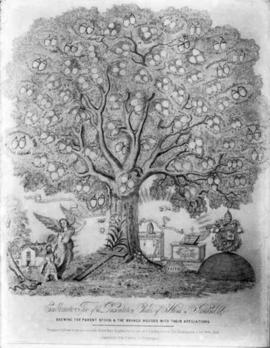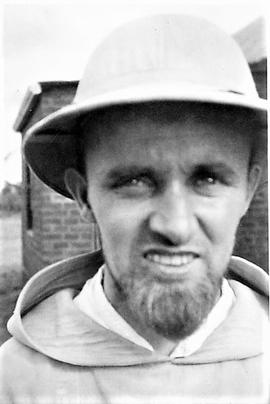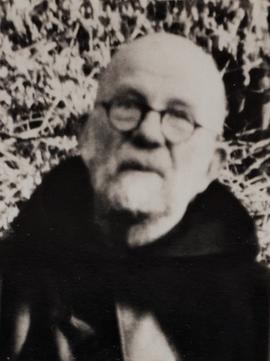- PB
- Corporate body
- 1795-2021
The Presentation Brothers are an international, Catholic congregation of religious brothers, founded in 1802 by Blessed Edmund Rice in Waterford, Ireland. The expressed mission of the Presentation Brothers is to "form Christ in the Young" and traditionally they have worked to achieve this through education.
Edmund Rice was born in the townland of Westcourt near the village of Callan in County Kilkenny on 1 June 1762. His parents, Robert Rice and Margaret Tierney Murphy, were prosperous farmers. At the age of 17, Rice was apprenticed to his uncle, Michael Rice, in Waterford city. Several years later, Edmund’s uncle signed the business over to him and Edmund began to invest his growing fortune in land and property. At the age of 25, Edmund married Mary Elliott but, sadly, Mary died in January 1789 following a horse-riding accident. Edmund and Mary had a daughter who was also called Mary.
After his wife’s death, Rice became more religious and he developed a devotion to St. Teresa of Avila. He also became involved in charitable works and regularly visited the poor of Waterford providing financial assistance to those in need. In 1798, Edmund helped the Presentation Sisters open a convent and school for girls in Waterford. Rice decided to try something similar for young boys, and in 1800 he began to teach youngsters at his business premises in Barronstrand Street with the assistance of some volunteers. The following year, Rice converted some stables on New Street into a makeshift school. His friends and colleagues described it as an act of "mad folly". Two men, Patrick Grosvenor and Patrick Finn, arrived to help. The three men lived above the school where they prayed together and shared their possessions. This school would go on to be known as Mount Sion Primary School which exists to this day.
Between 1802, when he opened his first school and 1808, Rice gathered around him a group of companions to help him in his work. These first Brothers took their vows on 15th August 1808 in the chapel of the Presentation Convent, Waterford, and together they became known as the Society of the Presentation. They lived their religious life based on the Rule of the Presentation Sisters (founded by the Venerable Nano Nagle in 1775), adapted for men. The Presentation Rule defined the new institute as a diocesan institute. This meant that, initially in Waterford, and later on in other dioceses where the Brothers worked, the local Bishop was their Superior. Unlike institutes of pontifical rite, the new religious institute had no Superior General of its own.
As the work of Edmund Rice expanded to Dublin, Cork and other Irish cities and towns, a need for central planning and direction emerged in the developing educational mission of the Brothers. From 1817 onwards, Edmund Rice began to consider adopting a constitution along the lines of that used by the Brothers of the Christian Schools in France. The De La Salle Brothers were an institute of pontifical rite, and had their own Superior General and elected administration. They were, to a great extent, independent of local bishops and this gave them great freedom in the development and expansion of their work. Rice felt that the Presentation Rule had served the group well in its early years, but Rome would only grant his group pontifical status if they adopted a pontifical rule already in existence. He decided to propose to his Brothers that the group should adopt a new De La Salle style rule. Controversy and debate ensued over a number of years and ultimately led to a division within the group. The vast majority of the Brothers ultimately accepted the adoption of a rule along the lines of that used by the Brothers of the Christian Schools in France. A minority of two continued to live the Presentation Rule and remained under the jurisdiction of their local bishops. The majority, known as the Christian Brothers since 1822, elected Edmund Rice as their first Superior General. The group experienced considerable expansion and development during the following decades.
Of the two Brothers who chose to remain with the Presentation Rule, Brother John Ignatius Mulcahy taught at a school in Cappoquin, County Waterford until his death in 1845. He was not joined by any followers. The second Brother, Michael Augustine Riordan of Cork, was joined by a number of followers and continued to follow the Presentation rule.
Brother Michael Augustine Riordan had entered the North Monastery in Cork in 1814 (there had been a community of Brothers in Cork since 1811; Brother Jerome O'Connor and Brother John Baptist Leonard founded the Peacock Lane Monastery, also known as the North Presentation Monastery, and were given charge of the Cork Charitable Society’s North School off Chapel Lane by the Bishop of Cork, Dr Francis Moylan). There had been considerable division in the North Monastery concerning the acceptance of the new rule over a number of years. An architect by profession, Riordan had helped in the building of many Cork churches before his entrance to the Brothers. His personal sense of loyalty to the then Bishop of Cork, John Murphy, greatly influenced his decision to remain with the Presentation Rule. In 1827, with the support of Bishop Murphy, he left the North Monastery and was given a house in Douglas Street, on the south side of the city. This became known as the South Monastery and Brother Riordan was joined there by some companions who lived as Presentation Brothers under the jurisdiction of the Bishop of Cork.
The Brothers began to conduct two schools in the city, one in the South Monastery itself, another a Lancasterian School on Great George's Street, today known as Washington Street. Thus, Brother Riordan played a pivotal role in the survival of the Institute of Presentation Brothers who would continue to live the original rule chosen by Edmund Rice and his early companions.
The Presentation Brothers continued their work in the Cork schools and expanded to Kerry in 1838. A foundation was made in Deptford, England in 1876 and in Birr, Co. Offaly, in 1879. By the 1870s however, a new younger group of Brothers began to address the issue of diocesan versus central control. As various types of schools were founded in diverse places, it became obvious that the Presentation Congregation should develop from its present diocesan status to being an institute of pontifical rite. In 1874, the Bishops of Cork and Kerry, on behalf of the Brothers, requested Rome to grant pontifical approval to the Presentation Institute. A Decree was received from Rome in the same year granting temporary approvaI. In 1885, the Presentation Brothers submitted a petition to Rome requesting its approval for a central government for the Presentation Institute under its own Superior General. By 1889, Rome granted temporary approval and final approbation came ten years later in 1899.
Throughout these developments, the Brothers retained the original Presentation Rule. Changes were inserted however to allow for a central government under a superior general and council. The first formal general chapter of the Brothers of the Presentation Institute was held in the South Monastery Cork in July 1889. Brother Patrick Shine was elected superior general and with him four assistants to help in the government of the Congregation.
The number of communities and schools established and managed by the Presentation Brothers greatly increased in the subsequent decades, both in Ireland (including Cork, Cobh, Kinsale, Bray, Dungannon, Enniskillen, Carrick-on-Shannon, Boyle, Letterkenny) and overseas (including Canada, USA, Ghana, Nigeria, Barbados, Grenada, St Lucia, Trinidad and Tobago, Peru, and Slovakia).
The Presentation Brothers have a presence in a number of these locations to the present day, and continue to work in the area of education as well as a wider range of ministries including with the homeless, elderly, disadvantaged youth and the Roma people.
Much of this history of the Presentation Brothers was sourced from 'The Contribution of the Presentation Brothers to Irish Education 1960-1998: A Study of a Roman Catholic Religious Teaching Institute in a Time of Change and Transition', a PhD thesis written and submitted to the University of Hull by Br Michael Martin Kenneally.









